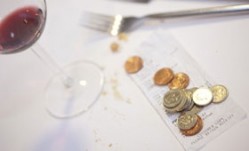Ask the Experts: How should my business handle the next VAT rise?

Problem: “I’m concerned about next year’s VAT rise and what it will mean for my business and hospitality at large. Also, will the big retailers be passing the rises on?” - Tim Gardner, director of The Londsdale bar and restaurant in Notting Hill.
Solution: The increase in VAT on 4 January (not 1 January to the industry’s vast relief) presents a challenge to any business. It’s destined to raise over £1bn a year from the UK hospitality industry so, while the increase to 20 per cent doesn’t seem much, in total it’s quite significant.
For businesses making a turnover of £1m, the 2.5 per cent VAT increase is worth £25k. Should this be passed on in full, in part, or, in view of the difficulties faced by most restaurants, will it scare the customers away and should the business try to absorb it?
Of course, the answer depends on the individual business, its present profitability and on its estimate of future demand.
If demand in strong, then most businesses will want to increase prices to take care of it in full. If demand is weak, many businesses will hesitate about raising prices and will seek to absorb all or part of the increase. But if you’re running that £1m business, do you want to absorb a loss of £25k?
The answer is probably no – and that is likely to be the response of most businesses. So charge the full 20 per cent, but recognise the dangers and try to alleviate the impact.
For example, if you’re charging £19.95 for two courses with VAT at 17.5 per cent, the charge with VAT at 20 per cent would amount to £20.37 – an awkward amount. So it would actually be better to charge £20.40 or possibly £20.50.
If you take this route, take care not to devalue the offer by cutting back on costs; far better to add something to the value to make sure that people think you’re giving them something extra.
Re-engineer menus
But, by far the best course of action is to take the VAT rise as an opportunity to re-engineer your menu so that any price rises can go unnoticed and untraced. Remember that with rising energy and utility costs, higher rates, perhaps higher rents, you may have to increase prices anyway. Best, therefore, to introduce new dishes and revamp popular ones or (more dangerously) reduce portion sizes, so that existing customers can welcome the new items and be unable to compare the new prices with those you charged before. They will also be unaware that they are paying 20 per cent VAT.
In the final analysis, raising VAT to 20 per cent on menu prices is unwelcome but it should not be catastrophic. Did you take the same amount off when VAT was reduced to 15 per cent - and did that make a difference to demand and revenues? Restaurant menus have so many different items, all at different prices that few customers (except, perhaps, those in heavily promoted fast food restaurants) will be aware of such a relatively small increase. But to the restaurateur, it all adds up so it still needs to be handled with care.
Ideally, the customer should be persuaded that while he’s paying more, he’s also getting better value. But that’s the trick every successful restaurateur plays.
How hotels can handle the VAT rise
There is less flexibility when it comes to increasing VAT in hotels – you either have to add it or absorb it and presumably, if the latter, cut costs so that the bottom line isn’t endangered. Yet hotel prices tend to vary significantly from day to day and week to week, particularly on web sites, so the rate of VAT is hardly a consideration for the consumer: the important figure is the price at the time when he purchases the room.
But the only option for a hotel company promoting its rooms at a specific price - £29.95 for example – and not wanting to go above that rate for marketing reasons, is to absorb the increase. At the same time, it will want to take measures to find savings elsewhere in the organization in order to maintain yield and profitability.
HM Revenue and Customs has issued a useful guide on www.hmrc.gov.uk/budget2010/vat.htm





















